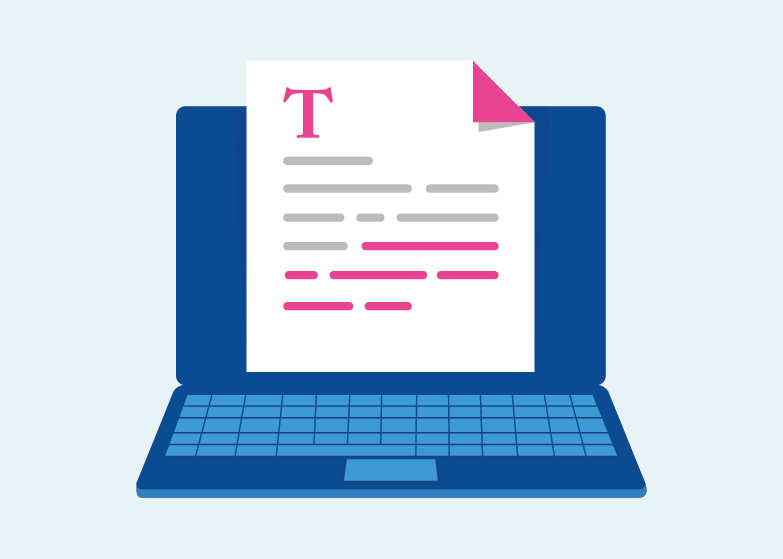
APA outlines for formatting specifics for the student paper.
Set margins to one inch at the top, bottom, and on both sides of the text of the research paper.
Font options include
- sans serif fonts such as 11-point Calibri, 11-point Arial, or 10-point Lucida Sans Unicode, or
- serif fonts such as 12-point Times New Roman, 11-point Georgia
In general, line spacing is double-spaced in all parts of an APA Style paper. Table and figure numbers may use other formatting depending on what is most effective for the information. Do not add extra space before or after paragraphs.
In the upper half of the title page, centre and double-space the title of the research paper, your name, the Department (or School), the name of the college, the course code and full official name of the course, your professor's full name, and the due date of the assignment. Only the title is bolded.
There are 5 possible heading levels that indicate a document's structure and how the content is organized so the reader can easily find the information they need.
Pagination appears only in the upper right corner one inch from the top of the page in the header. Number all pages consecutively throughout the research paper (from page one and onwards). Note: There is no title in the header on the student paper (only in the professional paper).
The second page contains the title again in bold and centred on the page. All text should be double spaced. Indent (1/2 inch) the first line of each new paragraph.
Papers usually end with a concluding section, often called the discussion and is your opportunity to evaluate and interpret the results of your study or paper, draw inferences and conclusions from it, and communicate its contributions to science and/or society. Use the present tense when writing the Discussion section.
If using a direct block quotation (40 words or more), it is displayed in a double-spaced block of text indented 1/2 inch from the left margin. Do not enclose the text in quotation marks. At the end of the quotation, provide the citation (author's name, date, and page number, if not already mentioned in the text) in parentheses after the final punctuation mark.
Mechanics of punctuation & spelling
Ensure clear, consistent communication and presentation in written works, for example, American vs. Canadian or British English spelling
Verbs are direct, vigorous communicators. Use a chosen verb tense consistently throughout the same and adjacent paragraphs of a paper to ensure smooth expression.
Voice describes the relationship between a verb and the subject and object associated with it.
Use first-person pronouns in APA Style to describe your work as well as your personal reactions.
The singular “they” is a generic third-person singular pronoun in English.
American Psychological Association. (2023). Style grammar and guidelines. https://apastyle.apa.org/
| 1" margin | |||
| 1" margin |
|
1 | 1" margin |
|
Effects of Age on Detection of Emotional Information Jane R. Smith School of Health Sciences, Nursing and Emergency Services, Cambrian College BSN 1007: Health and Healing I Prof. Name Assignment Due Date |
| 1" margin |
| 1" margin |
|
2 | 1" margin |
| Indent first line 1/2 inch |
Effects of Age on Detection of Emotional Information Age differences were examined in effective processing. In the context of a visual search task, young and older adults were faster to detect high arousal images... |
| 1" margin |
| 1" margin |
|
3 | 1" margin |
| Indent first line 1/2 inch |
Frequently, people encounter situations in their environment in which it is impossible to attend to all available stimuli... |
| 1" margin |
| 1" margin |
|
5 | 1" margin |
Indent block text 1/2 inch |
It has been noted that in comparison to young adults, older persons exhibit an overall detection advantage for emotional images compared with neutral images: For older adults, all emotional categories of targets were detected more rapidly than were neutral targets, . . . and RTs to the different emotion categories of targets did not differ significantly from one another. Thus, these results provided some evidence that older adults may show a broader advantage for detection of any type of emotional information. (Leclerc & Kensinger, 2008, p. 213) |
Navigating the not-so-hidden treasures of the APA Style website
FIND ANSWERS TO:
What terms should you capitalise in your paper?
How do you use numbers accurately in your paper?
When should you use italics in your paper?
How do you avoid anthropomorphism in your paper?
Which list type should you use in your paper: a lettered list, a numbered list, or a bulleted list?
How do you cite and reference secondary sources?
How do you cite and reference works that aren’t as common as a book or periodical article, such as a lab manual?
What is ...
Self-plagiarisam
Reference twins
Personal communications
Report and gray literature references
 Academic Writer Tutorial - The Basics
Academic Writer Tutorial - The Basics Paper format
Paper format Paragraph Alignment and Indentation
Paragraph Alignment and IndentationHow your paper should look!
The template demonstrates the format and how to use heading levels in an APA Style.
The title page includes title, author, course, name, due date ... among other details
Paper format, inclusive language, and references
Use this Checklist or this more detailed Checklist while writing your paper to make sure it is consistent with seventh edition APA Style.
There are two kinds of transitions: (a) transitional words and (b) transitional sentences. This handout covers only transitional words and phrases.
Papers usually end with a concluding section, often called the “Discussion.” where you evaluate and interpret the results of your paper, draw inferences and conclusions from it, and communicate its contributions to science and/or society.
American Psychological Association. (2023). Style grammar and guidelines. https://apastyle.apa.org/